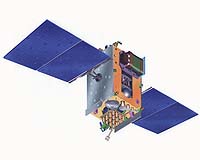 |
Huntsville AL (SPX) Apr 20, 2010 An engine nozzle turns a dramatic array of colors during a recent hot-fire test at NASA's White Sands Test Facility near Las Cruces, N.M. A team of engineers from Glenn Research Center in Cleveland, Ohio, Marshall Space Flight Center in Huntsville, Ala., and Johnson Space Center in Houston conducted tests on a cryogenic liquid oxygen and liquid methane engine to measure the engine's performance for future use with in-space vehicles. Last month, eight altitude chamber tests were performed using an Aerojet workhorse engine to gather design data for future lander and in-space engines. Using the altitude chamber, which simulates the space-type vacuum environment, engineers were able to attach a larger nozzle and vary the propellant mixture ratios to test the engine's overall operating capability. This technology could be selected for future use with vehicles designed for transport, descent, or ascent to another planetary body or asteroid. The nozzle, or large bell-shaped hardware, directs the flow of the combustion products from the liquid methane fuel and liquid oxygen oxidizer mixture and accelerates the exhaust gasses to generate thrust. The nozzle material is made of columbium and heats up during the test causing the color change. The nozzle is radiatively cooled and once the engine shuts down, the nozzle returns to its previous color. Another test objective was to look at the specific impulse, or gas mileage, this engine could provide to a space vehicle. Specific impulse is simply a measurement of the amount of thrust that can be attained per mass of rocket propellant consumed. The higher specific impulse attained improves the overall rocket performance and reduces the weight of propellants that need to be carried on the vehicle. Overall, the test series was successful and valuable performance data was obtained. Data received from the tests is currently being reviewed to ensure the engine performed as expected on a continual basis with each individual test. Engineers will continue to vary and refine the engine test parameters to evaluate the technology further. Developing technology is a test-rich process to ensure as many unknowns are worked out on the ground before this technology is put into application in a space environment. The cryogenic liquid oxygen and liquid methane effort is part of the Propulsion and Cryogenics Advanced Development (PCAD) project at Glenn, which is developing cryogenic propulsion technologies for future space exploration missions. The PCAD project is funded by the Exploration Technology Development Program in NASA's Exploration Systems Mission Directorate.
Share This Article With Planet Earth
Related Links Glenn Research Center Rocket Science News at Space-Travel.Com
 GSAT-4 Rocket Lost, But Precious Payload Safe
GSAT-4 Rocket Lost, But Precious Payload SafeBangalore (IANS) Apr 19, 2010 A fateful but providential decision by the Indian Space Research Organisation (ISRO) saved a precious Indo-Israeli science payload from crashing into the sea in the failed GSLV launch mission Thursday. Under the original plan, the ultraviolet telescope called TAUVEX was to be carried by GSAT-4, which plunged into the Bay of Bengal after the indigenously built cryogenic stage failed to fire ... read more |
|
| The content herein, unless otherwise known to be public domain, are Copyright 1995-2010 - SpaceDaily. AFP and UPI Wire Stories are copyright Agence France-Presse and United Press International. ESA Portal Reports are copyright European Space Agency. All NASA sourced material is public domain. Additional copyrights may apply in whole or part to other bona fide parties. Advertising does not imply endorsement,agreement or approval of any opinions, statements or information provided by SpaceDaily on any Web page published or hosted by SpaceDaily. Privacy Statement |